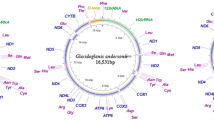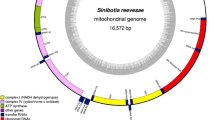Abstract
The elasmobranchs (sharks, rays and skates) being the extant survivors of one of the earliest offshoots of the vertebrate evolutionary tree are good model organisms to study the primitive vertebrate conditions. They play a significant role in maintaining the ecological balance and have high economic value. Due to over-exploitation and illegal fishing worldwide, the elasmobranch stocks are being decimated at an alarming rate. Appropriate management measures are necessary for restoring depleted elasmobranch stocks. One approach for restoring stocks is implementation of conservation measures and these measures can be formulated effectively by knowing the evolutionary relationship among the elasmobranchs. In this study, a total of 30 species were chosen for molecular phylogeny studies using mitochondrial cytochrome c oxidase subunit I, 12S ribosomal RNA gene and nuclear Internal Transcribed Spacer 2. Among different genes, the combined dataset of COI and 12S rRNA resulted in a well resolved tree topology with significant bootstrap/posterior probabilities values. The results supported the reciprocal monophyly of sharks and batoids. Within Galeomorphii, Heterodontiformes (bullhead sharks) formed as a sister group to Lamniformes (mackerel sharks): Orectolobiformes (carpet sharks) and to Carcharhiniformes (ground sharks). Within batoids, the Myliobatiformes formed a monophyly group while Pristiformes (sawfishes) and Rhinobatiformes (guitar fishes) formed a sister group to all other batoids.


Similar content being viewed by others
References
Heinicke MP, Naylor GJP, Hedges SB (2009) Cartilaginous fishes (Chondrichthyes). In: Hedges SB, Kumar S (eds) The time tree of life. Oxford University Press, New York, p 320
Iglésias SP, Lecointre G, Sellos DY (2005) Extensive paraphylies within sharks of the order Carcharhiniformes inferred from nuclear and mitochondrial genes. Mol Phylogenet Evol 34:569–583
Naylor GJP, Ryburn JA, Fedrigo O, Lopez A (2005) Phylogenetic relationships among the major lineages of modern elasmobranchs. In: Hamlett WC, Jamieson BGM (eds) Reproductive biology and phylogeny of chondrichthyes: sharks, batoids, and chimaeras, vol 3. Science Publishers, Inc., Enfield, pp 1–25
Human BA, Owen EP, Compagno LJV, Harley EH (2006) Testing morphologically based phylogenetic theories within the cartilaginous fishes with molecular data, with special reference to the cat shark family (Chondrichthyes; Scyliorhinidae) and the interrelationships within them. Mol Phylogenet Evol 39:384–391
Lopez JA, Ryburn JA, Fedrigo O, Naylor GJ (2006) Phylogeny of sharks of the family Triakidae (Carcharhiniformes) and its implications for the evolution of carcharhiniform placental viviparity. Mol Phylogenet Evol 40:50–60
Cavalcanti MJ (2007) A phylogenetic super tree of the hammerhead sharks (Carcharhiniformes: Sphyrnidae). Zool Stud 46:6–11
Corrigan S, Beheregaray LB (2009) A recent shark radiation: molecular phylogeny, biogeography and speciation of wobbegong sharks (family: Orectolobidae). Mol Phylogenet Evol 52:205–216
Lim DD, Motta P, Mara K, Martin AP (2010) Phylogeny of hammerhead sharks (Family Sphyrnidae) inferred from mitochondrial and nuclear genes. Mol Phylogenet Evol 55:572–579
Eitner BJ (1995) Systematics of the genus Alopias (Lamniformes: Alopiidae) with evidence for the existence of an unrecognized species. Copeia 3:562–571
Dosay-Akbulut M (2008) The phylogenetic relationship within the genus Carcharhinus. C R Biol 331:500–509
Stelbrink B, von Rintelen T, Cliff G, Kriwet J (2009) Molecular systematics and global phylogeography of angel sharks (genus Squatina). Mol Phylogenet Evol 54:395–404
Sambrook SJ, Russel DW, Janssen KA, Irwuin NJ (2001) Molecular cloning, a laboratory manual, 3rd edn. Cold Spring Harbor Laboratory Press, New York
Ward RD, Zemlak TS, Innes BH, Last PR, Hebert PDN (2005) DNA barcoding Australia’s fish species. Philos Trans R Soc Lond B Biol Sci 360:1847–1857
Folmer O, Black M, Hoeh W, Lutz R, Vrijenhoek R (1994) DNA primers for application of mitochondrial cytochrome c oxidase subunit I from diverse metazoan invertebrates. Mol Mar Biotechnol 3:294–297
Palumbi SR, Martin AP, Croom H, McMillan WO, Romano S et al (1991) The simple fool’s guide to PCR. University of Hawaii Special Publication, Honolulu
Pank M, Stanhope M, Natanson L, Kohler N, Shivji M (2001) Rapid and simultaneous identification of body parts from the morphologically similar sharks Carcharhinus obscurus and Carcharhinus plumbeus (Carcharhinidae) using multiplex PCR. Mar Biotechnol 3:231–240
Tamura K, Peterson D, Peterson N, Stecher G, Nei M, Kumar S (2011) MEGA5: molecular evolutionary genetics analysis using maximum likelihood, evolutionary distance, and maximum parsimony methods. Mol Biol Evol 28:2731–2739
Maddison WP, Maddison DR (2009) Mesquite: a modular system for evolutionary analysis. Version 2.72. CRC Press, Washington, DC, pp 3–31
Swofford DL (2003) PAUP: phylogenetic analysis using parsimony (and other methods), version 4.0b10. Sinauer Associates, Sunderland
Xia X, Xie Z (2001) DAMBE: data analysis in molecular biology and evolution. J Hered 92:371–373
Farris JS, Kallers M, Kluge AG, Bult C (1995) Constructing a significance test for incongruence. Syst Biol 44:570–572
Posada D (2008) jModelTest: phylogenetic model averaging. Mol Biol Evol 25:1253–1256
Farris JS (1970) Methods for computing Wagner trees. Syst Zool 19:83–92
Felsenstein J (1985) Confidence limits on phylogenies: an approach using the bootstrap. Evolution 39:783–791
Huelsenbeck JP, Ronquist F (2003) MR BAYES 3: Bayesian phylogenetic inference under mixed models. Bioinformatics 19:1572–1574
Murphy WJ, Eizirik E, Brien SJ, Madsen O, Scally M, Douady CJ, Teeling E, Ryder OA, Stanhope MJ, de Jong WW, Springer MS (2001) Resolution of the early placental mammal radiation using Bayesian phylogenetics. Science 294:2348–2351
Bull JJ, Huelsenbeck JP, Cunningham CW, Swofford DL, Waddell PJ (1993) Partitioning and combining data in phylogenetic analysis. Syst Biol 42:384–397
Yoder AD, Irwin JA, Payseur BA (2001) Failure of the ILD to determine data combinability for slow loris phylogeny. Syst Biol 50:408–424
Rokas A, Williams BL, King N, Carroll SB (2003) Genome-scale approaches to resolving incongruence in molecular phylogenies. Nature 425:798–804
Akaike H (1974) A new look at the statistical model identification. IEEE Trans Autom Control 19:716–723
Dunn KA, Morrissey JF (1995) Molecular phylogeny of elasmobranchs. Copeia 3:526–531
Kitamura T, Takemura A, Watabe S, Taniuchi T, Shimizu M (1996) Molecular phylogeny of the sharks and rays of superorder Squalea based on mitochondrial cytochrome b gene. Fish Sci 62:340–343
Arnason U, Gulberg A, Janke A (2001) Molecular phylogenetics of Gnathostomous (jawed) fishes: old bone, new cartilage. Zool Scr 30:249–255
Winchell CJ, Martin AP, Mallatt J (2004) Phylogeny of elasmobranchs based on LSU and SSU ribosomal RNA genes. Mol Phylogenet Evol 31:214–224
Lockhart PJ, Steel MA, Hendy MD, Penny D (1994) Recovering evolutionary trees under a more realistic model of sequence evolution. Mol Biol Evol 11:605–612
Loomis WF, Smith DW (1990) Molecular phylogeny of Dictyostelium discoideum by protein sequence comparison. Proc Natl Acad Sci USA 87:9093–9097
Kocher TD, Conroy JA, McKaye KR (1995) Evolution of NADH dehydrogenase subunit 2 in east African cichlid fish. Mol Phylogenet Evol 4:420–432
Lopez P, Forterre P, Philippe H (1999) The root of the tree of life in the light of the covarion model. J Mol Evol 49:496–508
Philippe H, Forterre P (1999) The rooting of the universal tree of life is not reliable. J Mol Evol 49:509–523
Aguilar C, Sánchez JA (2007) Phylogenetic hypotheses of gorgoniid octocorals according to ITS2 and their predicted RNA secondary structures. Mol Phylogenet Evol 43:774–786
Sullivan J, Holsinger KE, Simonb C (1995) Among site rate variation and phylogenetic analysis of 12S rRNA data in sigmodontine rodents. Mol Biol Evol 12:988–1001
Carstens CB, Lundrigan LB, Myers P (2002) A phylogeny of the neotropical nectar-feeding bats (Chiroptera: Phyllostomidae) based on morphological and molecular data. J Mamm Evol 9:23–53
Köhler F (2011) The camaenid species of the Kimberley Islands, Western Australia (Stylommatophora: Helicoidea). Malacologia 54:203–406
Mahendran B, Ghosh SK, Kundu SC (2006) Molecular phylogeny of silk-producing insects based on 16s ribosomal RNA and cytochrome oxidase subunit I genes. J Genet 85:31–38
Bigelow HB, Schroeder WC (1953) Part 2. Sawfishes, guitarfishes, skates and rays; chimaeroids. In: Tee-Van J et al (eds) Fishes of the western North Atlantic. Sears Foundation for Marine Research, Yale University, New Haven
Compagno LJV (1977) Phyletic relationships of living sharks and rays. Am Zool 17:303–322
deCarvalho MR, Maisey JG (1996) Phylogenetic relationships of the Late Jurassic shark Protospinax Woodward, 1919 (Chondrichthyes:Elasmobranchii). In: Arratia G, Viohl G (eds) Mesozoic fishes: systematics and paleoecology. Verlag Dr. Friedrich Pfiel, Munich, pp 9–46
Deets GB (1994) Copepod-chondricthyan coevolution: a cladistics consideration. Ph.D. Dissertation, University of British Columbia, Vancouver
Shirai S (1996) Phylogenetic interrelationships of neoselachians (Chondrichthyes: Euselachii). In: Stiassny MLJ, Parenti LR, Johnson GD (eds) Interrelationships of fishes. Academic Press, San Diego, pp 9–34
Douady CJ, Dosay M, Shivji MS, Stanhope MJ (2003) Molecular phylogenetic evidence refuting the hypothesis of Batoidea (rays and skates) as derived sharks. Mol Phylogenet Evol 26:215–221
Nishida K (1990) Phylogeny of the suborder Myliobatoidei. Mem Fac Fish 37:259–298
Kriwet J (2004) The systematic position of the Cretaceous sclerorhynchid sawfishes (Elasmobranchii, Pristiorajea). In: Arriata G, Tintori A (eds) Mesozoic fishes, vol 3. Dr. Friedrich Pfeil, Munich, pp 57–73
Compagno LJV (1973) Interrelationship of living elasmobranchs. In: Greenwood PH et al (eds) Interrelationships of fishes. Academic Press, New York, pp 15–61
Acknowledgments
The authors acknowledge Dr. Paul Hebert and Dr. Robert Hanner, University of Guelph, Canada and Dr. R. D. Ward, CSIRO Marine and Atmospheric Research, Australia for guidance and support and Indian Council of Agricultural Research, New Delhi for the financial support. We thank three anonymous reviewers for their comments, which strengthened the content of this article.
Author information
Authors and Affiliations
Corresponding author
Electronic supplementary material
Below is the link to the electronic supplementary material.
Rights and permissions
About this article
Cite this article
Pavan-Kumar, A., Gireesh-Babu, P., Babu, P.P.S. et al. Molecular phylogeny of elasmobranchs inferred from mitochondrial and nuclear markers. Mol Biol Rep 41, 447–457 (2014). https://doi.org/10.1007/s11033-013-2879-6
Received:
Accepted:
Published:
Issue Date:
DOI: https://doi.org/10.1007/s11033-013-2879-6




